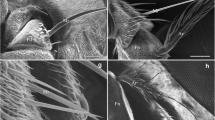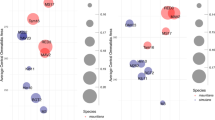Abstract
This work aims to elucidate the number of ommatidia or facets (the outwardly visible units of each ommatidium) for compound eyes in blow flies [Chrysomya megacephala (F.), Chrysomya rufifacies (Macquart), Chrysomya nigripes (Aubertin), Lucilia cuprina (Wiedemann)], house flies (Musca domestica L.), and flesh flies (Liosarcophaga dux Thomson) by manual counts of the corneal spreads. The head of the fly in each species was soaked in 20% potassium hydroxide solution at room temperature for 7 days, and the clear compound eye was dissected into six small parts, each of which was placed onto a slide and flattened using a coverslip. Images of each part were obtained using a microscope connected to a computer. The printed images of each part were magnified, and the total number of ommatidia per eye was manually counted. For males, the mean number of ommatidia was statistically different among all flies examined: L. dux (6,032) > C. rufifacies (5,356) > C. nigripes (4,798) > C. megacephala (4,376) > L. cuprina (3,665) > M. domestica (3,484). Likewise, the mean number of facets in females was statistically different: L. dux (6,086) > C. megacephala (5,641) > C. rufifacies (5,208) > C. nigripes (4,774) > L. cuprina (3,608) > M. domestica (3433). Scanning electron microscopy analysis of adult flies revealed the sexual dimorphism in the compound eye. Male C. megacephala had large ommatidia in the upper two thirds part and small ommatidia in the lower one third part, whereas only small ommatidia were detected in females. Dense postulate appearance was detected in the external surface of the corneal lens of the ommatidia of C. megacephala, C. rufifacies, and C. nigripes, while a mix of dense postulate appearance and variable groove array length was detected in L. cuprina and M. domestica. The probable functions of ommatidia are discussed with reference to other literature.




Similar content being viewed by others
References
Altner I, Burkhardt D (1981) Fine structure of the ommatidia and the occurrence of rhabdomeric twist in the dorsal eye of male Bibio marci (Diptera, Nematocera, Bibionidae). Cell Tissue Res 215:607–623
Anderson GS (2001) Insect succession on carrion and its relationship to determining time of death. In: Byrd JH, Castner JL (eds) Forensic entomology: the utility of arthropods in legal investigations. CRC, Boca Raton, FL, pp 143–175
Anderson MS, Gaimari SD (2003) Raman-atomic force microscopy of the ommatidial surfaces of Dipteran compound eyes. J Struct Biol 142:364–368
Baker GT, Ma PWK (2006) Morphology and number of ommatidia in the compound eyes of Solenopsis invicta, Solenopsis richteri, and their hybrid (Hymenoptera: Formicidae). Zool Anz 245:121–125
Bernhard CG, Gemne G, Sällström Z (1970) Comparative ultrastructure of corneal surface topography in insects with considerations on phylogeny and function. Z Vergl Physiol 67:1–25
Bidawid SP, Edeson JF, Ibrahim J, Matossian RM (1978) The role of non-biting flies in the transmission of enteric pathogens (Salmonella species and Shigella species) in Beirut, Lebanon. Ann Trop Med Parasitol 72:117–121
Bitsakos K, Fermüller C (2006) Depth estimation using the compound eye of dipteran flies. Biol Cybern 95:487–501
Blaney WM (1977) How insects live. Galley Press, England, p 160
Buschbeck EK (2005) The compound lens eye of Strepsiptera: morphological development of larvae and pupae. Arthropod Struct Dev 34:315–326
Byrd JH, Castner JL (2001) Insects of forensic importance. In: Byrd JH, Castner JL (eds) Forensic entomology: the utility of arthropods in legal investigations. CRC, Florida, pp 43–79
Chapman RF (1998) The insects structure and function,4th edn. Cambridge University Press, Cambridge
Crosskey RW (1993) Blackflies (Simuliidae). In: Lane RP, Crosskey RW (eds) Medical insects and arachnids. British Museum (Natural History), London, pp 241–287
Dander U, Jander R (1994) Numerical allometric growth of the ommatidia, antennal sensilla, and teeth of foretibial combs in the milkweed bug Oncopeltus fasciatus Dallas (Heteroptera: Lygaeidae). Int J Insect Morphol Embryol 23:329–344
Dey S, Dkhar B (1992) An unusual type of corneal nipple in the earwig, Forficula sp., with a possible anti-reflection role. Micron Microsc Acta 23:337–339
Elzinga RJ (2004) Fundamentals of entomology, 6th edn. Pearson Education, Inc., New Jersey, p 512
Goff ML (2000) A fly for the prosecution: how insect evidence helps solve crimes. Harvard University Press, Cambridge, MA, p 225
Greenberg B (1971) Flies and disease. Vol. I. Ecology, classification and biotic associations. Princeton University Press, New Jersey
Greenberg B (1973) Flies and disease. Vol. II. Biological and disease transmission. Princeton University Press, New Jersey
Greenberg B, Kunich JC (2002) Entomology and the law. Flies as forensic indicators. Cambridge University Press, UK
Jander U, Jander R (2002) Allometry and resolution of bee eyes (Apoidea). Arthropod Struct Dev 30:179–193
Klotz JH, Reid BL, Gordon WC (1992) Variation of ommatidia number as a function of worker size in Camponotus pennsylvanicus (DeGeer) (Hymenoptera: Formicidae). Insect Soc 39:233–236
Lertthamnongtham S, Sukontason KL, Sukontason K, Piangjai S, Choochote W, Vogtsberger RC, Olson JK (2003) Seasonal fluctuations in populations of the two most forensically important fly species in northern Thailand. Ann Trop Med Parasitol 97:87–91
Meyer-Rochow VB, Mishra M (2007) Structure and putative function of dark- and light-adapted as well as UV-exposed eyes of the food store pest Psyllipsocus ramburi Sélys-Longchamps (Insecta: Psocoptera: Psylippsocidae). J Insect Physiol 53:157–169
Mishra M, Meyer-Rochow VB (2006) Fine structure of the compound eye of the fungus beetle Neotriplax lewisi (Coleoptera, Cucujiformis, Erotylidae). Invert Biol 125:265–278
Richards OW, Davies RG (1977) Imms' general textbook of entomology: structure, physiology and development, 10th edn. Chapman and Hall, London
Romoser WS, Stoffolano JGJ (1994) The science of entomology, 3rd edn. Wm. C. Brown Publishers, Dubuque
Shinonaga S (1965) The altitudinal distribution of flies on Mt. Fuji in summer season. Jpn J Sanit Zool 16:263–269
Smith KGV (1986) A manual of forensic entomology. Cornell University Press, Ithaca, NY
Sucharit S, Tumrasvin W, Vutikes S (1976) A survey on house flies in Bangkok and neighboring provinces. Southeast Asian J Trop Med Public Health 7:85–90
Sukontason K, Sukontason KL, Piangjai S, Tippanun J, Lertthamnongtham S, Vogtsberger RC, Olson JK (2003) Survey of forensically-relevant fly species in Chiang Mai, Northern Thailand. J Vector Ecol 28:135–138
Sukontason K, Sukontason KL, Ngern-klun R, Sripakdee D, Piangjai S (2004) Differentiation of the third instar of forensically important fly species in Thailand. Ann Entomol Soc Am 97:1069–1075
Sukontason K, Narongchai P, Kanchai C, Vichairat K, Sribanditmongkol P, Bhoopat T, Kurahashi H, Chockjamsai M, Piangjai S, Bunchu N, Vongvivach S, Samai W, Chaiwong T, Methanitikorn R, Ngern-klun R, Sripakdee D, Boonsriwong W, Siriwattanarungsee S, Srimuangwong C, Hanterdsith B, Chaiwan K, Srisuwan C, Upakut S, Moopayak K, Vogtsberger RC, Olson JK, Sukontason KL (2007a) Forensic entomology cases in Thailand: a review of cases from 2000 to 2006. Parasitol Res 101:1417–1423
Sukontason KL, Bunchoo M, Khantawa B, Piangjai S, Rongsriyam Y, Sukontason K (2007b) Comparison between Musca domestica and Chrysomya megacephala as carriers of bacteria in northern Thailand. Southeast Asian J Trop Med Public Health 38:38–44
Sukontason K, Methanitikorn R, Kurahashi H, Vogtsberger RC, Sukontason KL (2008) External morphology of Chrysomya pinguis (Walker) (Diptera: Calliphoridae) revealed by scanning electron microscopy. Micron 39:190–197
Talarico F, Romeo M, Massolo A, Brandmayr P, Zetto T (2007) Morphometry and eye morphology in three species of Carabus (Coleoptera: Carabidae) in relation to habitat demands. J Zool Syst Evol Res 45:33–38
Tan SW, Yap KL, Lee HL (1997) Mechanical transport of rotavirus by the legs and wings of Musca domestica (Diptera: Muscidae). J Med Entomol 34:527–531
Tumrasvin W, Sucharit S, Kano R (1978) Studies on medically important flies in Thailand. IV. Altitudinal distribution of flies belonging to Muscidae and Calliphoridae in Doi Indhanondh Mountain, Chiengmai, in early summer season. Bull Tokyo Med Dent Univ 25:77–81
Wada S (1974) Spezielle randzonale ommatidien von Calliphora Erythrocephala meig. (diptera calliphoridae): Architektur der zentralen rhabdomeren-kolumne und topographie im komplexauge. Int J Insect Morphol Embryol 3:397–424
Yack JE, Johnson SE, Brown SG, Warrant EJ (2007) The eyes of Macrosoma sp. (Lepidoptera: Hedyloidea): a nocturnal butterfly with superposition optics. Arthropod Struct Dev 36:11–22
Yang IF, Lin JT, Wu CY (1998) Fine structure of the compound eye of Mallada basalis (Neuroptera: Chrysopidae). Ann Entomol Soc Am 91:113–121
Ziemba SK, Rutowski RL (2000) Sexual dimorphism in eye morphology in a butterfly (Asterocampa leila; Lepidoptera, Nymphalidae). Psyche 103:25–36
Zumpt F (1965) Myiasis in man and animals in the old world. Butterworths, London
Acknowledgments
This work received support by grants from the Natth’s Bhamarapravati’s fund and the Thailand Research Fund (RMU4980007). We thank the Faculty of Medicine and Chiang Mai University for funding printing costs.
Author information
Authors and Affiliations
Corresponding author
Rights and permissions
About this article
Cite this article
Sukontason, K.L., Chaiwong, T., Piangjai, S. et al. Ommatidia of blow fly, house fly, and flesh fly: implication of their vision efficiency. Parasitol Res 103, 123–131 (2008). https://doi.org/10.1007/s00436-008-0939-y
Received:
Accepted:
Published:
Issue Date:
DOI: https://doi.org/10.1007/s00436-008-0939-y




